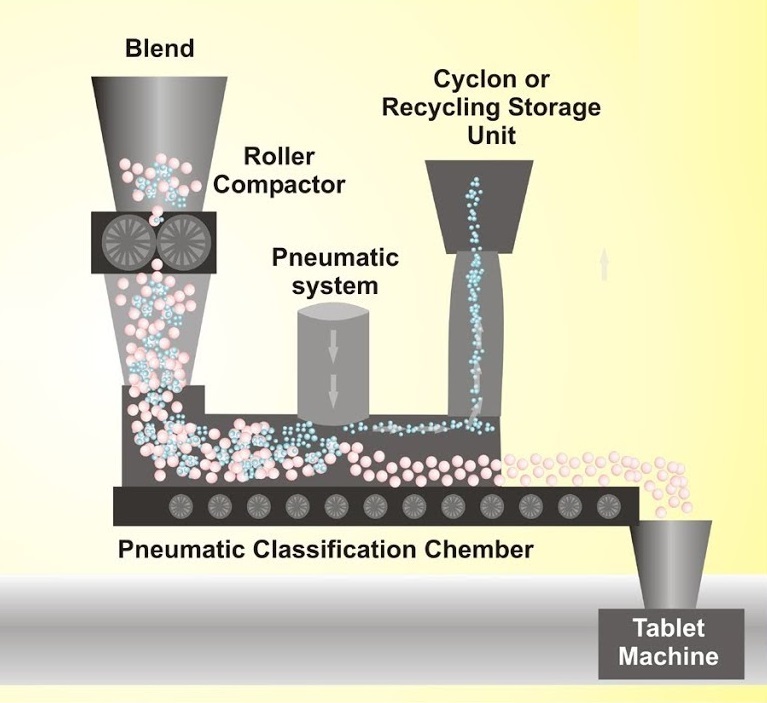Granulation, the method of particle enlargement by agglomeration technique, is one among the most vital unit operations in the production of pharmaceutical dosage forms, largely tablets and capsules. Granulation method transforms fine powders into free-flowing, dust-free granules that are simple to compress. Nonetheless, granulation poses various challenges because of top quality demand of the formed granules in terms of content uniformity and physicochemical properties like granule size, bulk density, porosity, hardness, moisture, compressibility, etc. beside physical and chemical stability of the drug. Granulation method may be divided into 2 types: wet granulation that utilize a liquid within the method and dry granulation that needs no liquid. The kind of method choice needs thorough information of physicochemical properties of the drug, excipients, and needed flow and release properties, to name some. Among presently available technologies, spray drying, roller compaction, high shear mixing, and fluid bed granulation are worth of note. Like several alternative scientific fields, pharmaceutical granulation technology conjointly continues to vary, and arrival of novel and innovative technologies are inevitable.
Recent progress in the granulation techniques and technologies such as:
- Pneumatic dry granulation
- Reverse wet granulation
- Steam granulation
- Moisture-activated dry granulation
- Thermal adhesion granulation
- Freeze granulation
- Foamed binder or foam granulation
Granulation, a method of particle enlargement by agglomeration, is one amongst the most important unit operations within the production of pharmaceutical dosage forms, largely tablets and capsules. Throughout the granulation method, tiny fine or coarse particles are converted into massive agglomerates referred to as granules. Generally, granulation commences when initial dry mixing of the required powder ingredients along with the active pharmaceutical ingredient (API), so that a regular distribution of every ingredient throughout the powder mixture is achieved.
The type of method choice needs thorough information of physicochemical properties of the drug, excipients, needed flow and release properties, etc. Granulation technologies like roller compaction, spray drying, supercritical fluid, and low/high shear mixing, fluid bed granulation, extrusion/spheronization, etc. are flourishing for several decades within the preparation of assorted pharmaceutical dosage forms. Pharmaceutical granulation technology continues to vary, and numerous improved, modified, and novel techniques and technologies are created out there on the course.
Dry granulation may be achieved either by roller compaction or by slugging. There has not been a lot of progress in the dry granulation technique and technology as compared to wet granulation, apart from one vital innovation called pneumatic dry granulation technology.
Pneumatic Dry Granulation (PDG)
Pneumatic dry granulation (PDG), an innovative dry granulation technology, utilizes roller compaction together with a proprietary air classification technique to supply granules with extraordinary combination of flow ability and compressibility. during this technique, granules are created from powder particles by at first applying gentle compaction force by roller compactor to supply a compacted mass comprising a combination of fine particles and granules. The fine particles and/or smaller granules are separated from the supposed size granules in a fractioning chamber by entraining in a gas stream (pneumatic system), whereas the supposed size granules undergo the fractioning chamber to be compressed into tablets. The entrained fine particles and/or tiny granules are then transferred to a device like a cyclone and are either came back to the roller compactor for immediate re-processing (recycling or recirculation process) or placed in a container for reprocessing later to attain the granules of desired size.
Wet granulation is the widely used technique and the granules are produced by wet massing of the excipients and API with granulation liquid with or without binder. Wet granulation has witnessed various technical and technological innovations such as:
- Steam granulation
- Moisture-activated dry granulation or moist granulation
- Thermal adhesion granulation
- Melt granulation
- Freeze granulation
- Foamed binder or foam granulation
- Reverse wet granulation
Technical and technological innovations that improve and ease existing processes may contribute to improved process ability and quality of the product formulations in addition to a considerable impact on the product development, time and economy. Obviously, the pharmaceutical granulation techniques and technologies have improved over the years. Nonetheless, efficient and cost-effective producing ways have continually been the keen interest of the pharmaceutical industries, that catapults the analysis and development of latest and improved technologies by the interdisciplinary scientists of pharmaceutical corporations globally. Throughout the formulation development, every drug substance poses a novel challenge that has got to be taken into consideration at the method selection stage by the formulation development scientists. every technique has its own merits and limitations, and therefore the variety of technique and technology selection needs thorough knowledge of physicochemical properties of the drug, excipients, needed flow and release properties, etc. in addition to the granulation techniques and technologies itself.
In the pharmaceutical industry, although numerous technologies are introduced from time to time, only few have emerged as productive for real time utilization because of completely different types of hurdles like manufacturing efficiency, economy, regulatory issues, etc.
We at KERONE have a team of experts to help you with your need for granulation techniques and technologies in various products range from our wide experience.

